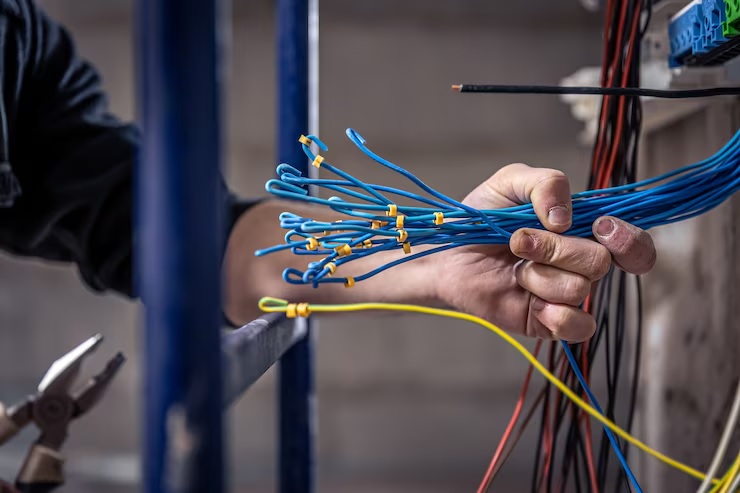Cable factories are busy places – heavy machinery humming, massive drums of cable moving around, high temperatures in some areas. While essential for producing the cables that connect our world, these environments can also pose risks to the hardworking people on the factory floor. Ensuring worker safety is priority number one, and thankfully, technology is offering powerful solutions. Automation and robotics are stepping in, not to replace humans, but to take on the most dangerous and demanding tasks, creating significantly safer workplaces.
Table of Contents
What Makes Cable Manufacturing Risky?
Let’s be real – making cables involves some inherent challenges for workers:
- Heavy Lifting: Those giant drums (reels) of finished cable can weigh tons! Moving them manually is a major cause of back injuries and strains. Even handling raw materials like copper wire coils can be physically demanding.
- Repetitive Tasks: Coiling smaller cables, cutting lengths, or packaging products over and over again can lead to painful repetitive strain injuries (RSIs) over time.
- Hot Spots: Processes like plastic extrusion involve very high temperatures, creating burn risks and uncomfortable working conditions nearby.
- Sharp Objects & Moving Parts: Handling wires, cutting tools, and working near complex machinery always carries risks of cuts, pinches, or entanglement.
- Electrical Hazards: Testing high-voltage cables requires strict safety protocols.
While safety procedures are crucial, automation offers a way to engineer many of these hazards out of the daily routine.
How Automation & Robotics Are Boosting Safety
Here’s how these technologies are making a tangible difference:
1. Taking the Weight Off Workers’ Shoulders
- Robotic Lifters & Palletizers: Instead of manual lifting, robots equipped with grippers can easily lift, move, and stack heavy cable drums onto pallets for shipping or storage.
- Automated Guided Vehicles (AGVs): Think of these as smart, self-driving carts. AGVs can transport heavy reels of raw materials or finished goods across the factory floor, eliminating the need for forklifts in crowded areas or manual pushing/pulling.
2. Banishing Repetitive Strain
- Automated Coiling & Spooling: Machines can automatically wind cables onto smaller spools or coils, precisely measuring length and tension without human intervention.
- Robotic Cutting & Packaging: Robots can handle the repetitive tasks of cutting cables to specific lengths, applying connectors (in some cases), and packaging finished products.
3. Keeping People Out of Harm’s Way
- Working in Extreme Heat: Robots are perfectly happy working right next to hot extrusion machines, monitoring the process or handling materials in high-temperature zones where humans would be uncomfortable and at risk.
- Handling Hazardous Materials: If specific chemicals are used (e.g., for certain types of insulation), robots can manage the handling and mixing, minimizing human exposure.
4. Safer Machine Operation
- Robotic Machine Tending: Robots can load raw materials into machines (like wire drawing machines or extruders) and unload finished parts, keeping human hands away from moving components and potential pinch points.
- Integrated Safety Systems: Modern automated lines often incorporate light curtains, pressure mats, or scanners. If a person enters a restricted operating zone, these systems automatically stop the machinery instantly.
5. Consistent Quality Checks Without Close Contact
- Automated Vision Systems: Cameras linked to AI software can inspect cables for insulation defects, diameter consistency, or surface flaws as they move along the production line, reducing the need for close manual inspection near moving parts.
- Sensor-Based Testing: Automated electrical testing or other sensor checks can be built directly into the line.
Real-World Examples on the Factory Floor
Imagine walking through a modern cable factory:
- You might see large robotic arms effortlessly stacking heavy drums of power cable.
- AGVs could be quietly delivering coils of copper wire, sourced from quality cable suppliers in uae, directly to the machines that need them.
- Extrusion lines might be largely enclosed, with robots handling material loading and sensors monitoring the process, requiring less direct human oversight in the immediate area.
- High-speed cameras might be scanning communication cables for tiny imperfections invisible to the naked eye.
More Than Just Safety
While safety is the prime driver, automation brings other benefits too:
- Increased Productivity: Robots can often work faster and longer than humans without fatigue.
- Improved Consistency: Automated processes lead to more uniform product quality.
- Reduced Errors: Automation minimizes the potential for human error in repetitive tasks.
Getting Automation Right
Implementing these systems effectively requires planning:
- Investment: Robots and automation systems represent a significant upfront cost.
- Skills: You need technicians skilled in programming, maintaining, and troubleshooting automated equipment.
- Risk Assessment: Ironically, you need a thorough safety assessment before installing safety automation to ensure it’s configured correctly and doesn’t introduce new, unforeseen risks.
- Training: The workforce needs training on how to safely operate and work alongside these new robotic colleagues.
Leading cable manufacturers in uae are increasingly investing in automation, recognizing that enhancing safety and improving efficiency go hand-in-hand in building a sustainable and competitive business.
Conclusion: A Safer Future, Built by Automation
Automation and robotics are fundamentally changing the landscape of cable manufacturing for the better. By taking over the most dangerous, strenuous, and repetitive tasks, these technologies are drastically reducing workplace injuries and creating healthier environments for employees. It’s not about replacing people, but about elevating their roles, allowing them to focus on more skilled tasks while robots handle the heavy lifting and hazardous work. The result is a safer, more efficient, and more productive future for the cable industry.
Your Safety Automation Questions Answered (FAQs)
- Does automation mean people will lose their jobs in cable factories?
While automation changes the type of jobs, it doesn’t necessarily eliminate them. It often shifts workers from manual, hazardous tasks to more skilled roles like operating, monitoring, and maintaining the automated systems, or performing complex quality checks. - What are the biggest safety benefits of using robots?
The main benefits include drastically reducing musculoskeletal injuries from heavy lifting, minimizing repetitive strain injuries, and removing workers from hazardous environments involving high heat, dangerous machinery, or potential chemical exposure. - Isn’t installing robots and automation really expensive?
There is a significant upfront investment. However, companies often find that the long-term savings from reduced injury costs (worker’s compensation, lost time), lower scrap rates, and increased productivity provide a strong return on that investment. - What kinds of robots are typically used in cable manufacturing?
You’ll often see large articulated robotic arms (like those used in car manufacturing) for heavy lifting and palletizing, smaller robots for machine tending or packaging, and Automated Guided Vehicles (AGVs) for material transport.
How exactly do robots help with lifting heavy cable drums?
Robots equipped with specialized grippers designed to securely hold large, heavy drums can be programmed to precisely lift, rotate, and place these drums onto pallets, trucks, or storage racks – tasks that pose significant injury risks when done manually.

